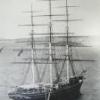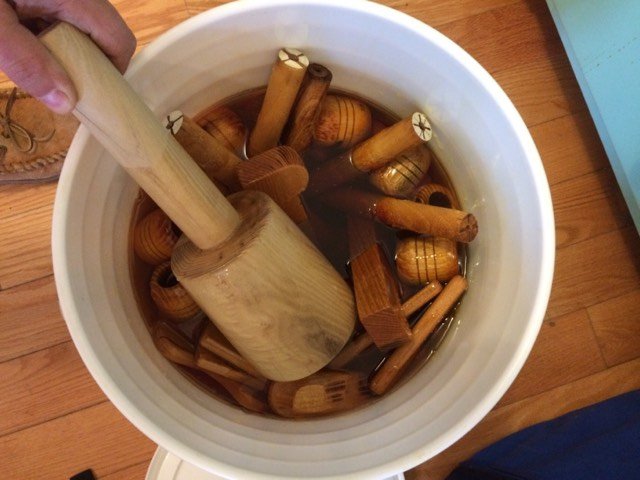-
Posts
994 -
Joined
-
Last visited
Content Type
Profiles
Forums
Gallery
Events
Everything posted by Sailor1234567890
-
A 5x4" section of iron almost 4 feet long? CRAZY huge compared to my little topmast fids.
- 3,618 replies
-
- young america
- clipper
-
(and 1 more)
Tagged with:
-
The P shaped block and the other larger block are my topmast fids. A lanyard hole is required yet but it is much more rectangular than square. Parral beads, parral dividers, belaying pins, my newly turned carving mallet and a centreboard cleat at the bottom of the image are the other bits you see there. It's all Black Locust, my favourite wood. Sorry, it's 1:1 scale.
- 3,618 replies
-
- young america
- clipper
-
(and 1 more)
Tagged with:
-
Those fid holes look square. I would have envisioned the fids rectangular in section and therefore taller than they are wide.
- 3,618 replies
-
- young america
- clipper
-
(and 1 more)
Tagged with:
-
Having narrowed down the conversation to French and English, we've neglected the Spanish ships. Montanes I understand had the beauty and sailing qualities of the French ships but the strength and longevity of the English. Anybody know about the Spanish 74s and are willing to weigh in on them?
-
Brass plated pedestals? I built a 1:96 Revell CS in probably the late 80s/early 90s. It certainly didn't have brass plated pedestals. Looks like that's a much nicer kit than the later production runs. I purchased another one on Ebay, maybe 8-10 years ago. It's partially finished, ready for rigging at this point. Again, no brass plated pedestals.
- 4 replies
-
- cutty sark
- revell
-
(and 2 more)
Tagged with:
-
I have a few as well. I have a french one about iron sailing ships between 1880 and 1930. I purchased it in Toulon a couple of years ago on the pretext that it would help me study for my french exams. Ha! That didn't work. It's still an interesting read. Sort of a Boudriot of French iron ships. The four posters and France with 5 certainly were a different beast for hauling volume but they could surely stand up to a blow. I seem to recall hearing somewhere that their lower tops'l sheets were not led to the deck but shackled to the course yard below as they were never furled at sea no matter what the conditions. Not sure of the veracity of that but it struck me as odd and as a testament to how strongly those ships were built. I'd love to have the opportunity to sail one (Kruzenshtern is the only one still sailing I think) but my real love is the little British tea clipper Cutty Sark. Sailing her would be a miracle dream come true for me. I'd replicate her given unlimited resources just so I can see what she's like running her easting down in the southern ocean.
-
I think Great Republic is a bit of an outlier, even amongst the larger ones, she's significantly larger. There's simply no comparison. How would the ones you've depicted compare with the iron four posters of the next generation size wise? Pommern, Padua, Lawhill, or the five master France? A bit outside the clipper ship area of expertise I guess but a valid question none the less.
-
I love the realism of your results Ed. Your work is awesome.
- 3,618 replies
-
- young america
- clipper
-
(and 1 more)
Tagged with:
-
Some would call playing with wires and stuff fumbling around but somehow a telephone was invented from that fumbling around. Call it what you like, we're calling it testing.
- 3,618 replies
-
- young america
- clipper
-
(and 1 more)
Tagged with:
-
Greg, I think the answer to your question lies in where Ed went with his reply. The tops in these ships wasn't used like it was in warships. As Ed mentioned, they sent marines up to fire down on the enemy. This isn't a working platform in a Clipper ship. There wasn't a whole lot of work to do up there. It was just climbed up to get to the next level. Most of the work was done on the yards themselves so not much need to spend much time in the tops so... no railing. That's how I see it anyway.
- 3,618 replies
-
- young america
- clipper
-
(and 1 more)
Tagged with:
-
I tend to think the 74s from about the 1780s and 90s are the nicest looking but they continued to build them for decades following that so there must have been improvements. I guess the improvements meant reducing weight higher up by eliminating decoration.
-
Ed, do you care to have a go at Great Republic in the same scale as your YA build? What a project that would be. Nice work Rob. Look forward to seeing the last few pics once you finish this project.
-
Just had a read through the relevant info in my copy of search for speed under sail. Very interesting reading even if one is not building the PdN.
- 359 replies
-
- prince de neufchatel
- model shipways
-
(and 1 more)
Tagged with:
-
I don't think of her as beautiful though. She's clunky looking in the stern to my eye and her bow seems clunky as well. I prefer ships a little older vintage, but not so far back as the mid 1700s. Late 1700s or to my eye but aesthetics are just one part of the package. A beautiful ship that's top-heavy and can't sail to windward is useless.
-
The later the ship the better the design theory seems born out by Frolick's comment that many seem to think USS Ohio to be the best and she's from 1820, toward the end of the time these vessels would have been built. I suppose I could ask the question another way, "If one were to replicate one today at full scale for the purpose of experiencing the best 74 gun ship experience we could without building in engines and other modern gizmos that take you out of the 18th and 19th century, what ship would one choose to replicate?"
-
Maybe a bit more detail is required. Clearly greatest could mean many things. I'm trying to figure out what class (or individual ship) had the best mix of sailing qualities, weatherliness, speed, firepower, seakeeping abilities in storms, stowage space for victuals and stores for long voyages, ease of maintenance etc. I'm sure some were better than others. Some classes were very small but other classes, such as the forty thieves were quite large. One can presume that if only one or two of a class were built, it was deemed not to be successful and they dropped it, while if they continued to build them (such as the forty thieves) one might presume they were successful. That isn't to say that the most prolific class was the best vessel. Any thoughts now that I've added a bit to my question?
-
As the title says, what ship (or class really) of 74 gun ship was the best of the breed? Most tend to lean toward the French ships but I really don't know. Temeraire maybe? I can't imagine the forty thieves would be considered for the award. What say you?
-
The carriages under the museum model guns are terrible. Why are they so basic in construction when the rest of the model is so nice?
- 1,035 replies
-
- royal katherine
- ship of the line
-
(and 1 more)
Tagged with:
-
I know, it looks like 1:1 at times. Incredible.
- 3,618 replies
-
- young america
- clipper
-
(and 1 more)
Tagged with:
-
It really is a shame the world never got to see her stretch her legs in those conditions. Anyone with extra deep pockets feel like an experiment?
-
Oh, I knew that size difference was pronounced. We're talking 960 tons vs 2500 and more. Not even the same ballpark. But still, both are quite similar in hull shape.
-
44 inches? That's mammoth. You could essentially call it 4 feet, it's close enough nobody would know the difference. 110 foot yard is pretty big as well. Who has the next longest? I think Cutty Sark's are interesting in that her fore and main yards were interchangeable which provided a bit of backup but also made her rig quite a bit larger than what was normally rigged on ships in those days.
About us
Modelshipworld - Advancing Ship Modeling through Research
SSL Secured
Your security is important for us so this Website is SSL-Secured
NRG Mailing Address
Nautical Research Guild
237 South Lincoln Street
Westmont IL, 60559-1917
Model Ship World ® and the MSW logo are Registered Trademarks, and belong to the Nautical Research Guild (United States Patent and Trademark Office: No. 6,929,264 & No. 6,929,274, registered Dec. 20, 2022)
Helpful Links
About the NRG
If you enjoy building ship models that are historically accurate as well as beautiful, then The Nautical Research Guild (NRG) is just right for you.
The Guild is a non-profit educational organization whose mission is to “Advance Ship Modeling Through Research”. We provide support to our members in their efforts to raise the quality of their model ships.
The Nautical Research Guild has published our world-renowned quarterly magazine, The Nautical Research Journal, since 1955. The pages of the Journal are full of articles by accomplished ship modelers who show you how they create those exquisite details on their models, and by maritime historians who show you the correct details to build. The Journal is available in both print and digital editions. Go to the NRG web site (www.thenrg.org) to download a complimentary digital copy of the Journal. The NRG also publishes plan sets, books and compilations of back issues of the Journal and the former Ships in Scale and Model Ship Builder magazines.




